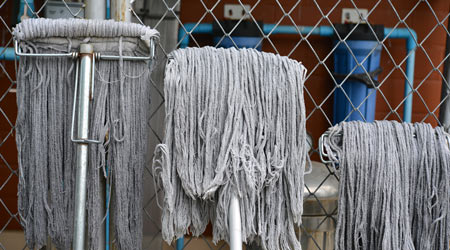
Laying floor finish with a dirty mop head is counter-intuitive to any janitor’s ultimate goal of obtaining the cleanest, shiniest floor possible.
But it happens, and generally it is because mop heads often are not cleaned properly or regularly. While it is often tempting to become lax in the mop cleanup process, especially after the laborious job of laying floor finish. But, the truth is, the added simple steps will prolong the mops’ usefulness.
“The basic rule is, you can’t clean with something that is dirtier than what you are trying to clean,” says Bill Griffin, president of the Seattle-based Cleaning Consultant Services.
String mops are still the go-to product for janitors when it comes to laying floor finish. But the products require special care. Even the most industrious of workers can be a little lazy in cleaning up his or her tools at the end of a long and tiring shift.
It may be obvious but it’s essential — janitors should lay finish on floors with mops that are clean.
“The reason why is to reduce the contamination of the floor finish that they are applying on their next job,” says Joe Choplin, the director of operations support for City Wide Franchise in Lenexa, Kansas, who also recommends a microfiber flat floor finish mop as opposed to a string mop to apply floor finish.
If using a dirty mop, the hard work a janitor puts into ensuring that the floors are smooth and glossy goes right out the window. Not only will the mop pick up debris, the mop itself begins to lose its shape.
“They smell, they’re dingy, and hard as a rock and turn yellow,” says Jill Frey, president of Cumming Facility Services located in Findlay, Ohio.
And when mops become too dirty to use, they have to be disposed of, which eventually adds up and hurts an operation’s bottom line.
Hilary Daninhirsch is a freelance writer based in Pittsburgh.
posted on 9/26/2016

 The Down and Dirty on Cleaning in Virus Season
The Down and Dirty on Cleaning in Virus Season How Surfactant Use is Expanding in Commercial Cleaning
How Surfactant Use is Expanding in Commercial Cleaning Operational Excellence Series 2025: Better Budgeting
Operational Excellence Series 2025: Better Budgeting
